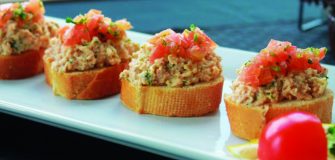Our Roots Run Deep: Ethnobotany – Where History and Medicine Meet the Forest
Share
“Sing a song
Full of Faith that the dark past has taught us
Sing a song
Full of the hope that the present has brought us”
James Weldon Johnson
Ethnobotany is the study of how people and cultures interact with plants. It intersects culture, medicine, and mythology.
In this article, we continue the discussion on the impact of the natural environment by the migration of people and plants to the Virgin Islands. During the Pre-Columbian time, those who lived here hunted, fished and practiced ‘slash and burn’ agriculture, with little effect on the environment.
The adventurous Columbus provided the impetus for the discovery of this “New World.” The lavish lifestyle of Europe spiraled the exploitation of the treasures of this New World, mining for tin, copper and iron and the cultivation of cash crops – sugarcane, cotton and tobacco.
These crops were grown utilizing thousands of acres spreading from the lower states in America, throughout the Caribbean and as far south as northern Argentina and southern Brazil. Here in the Caribbean, the environment and the indigenous peoples suffered a similar fate – decimation at the hands of the colonisers. The introduction of sugarcane plantations also brought a new concept – African slavery.
The enterprising Portuguese traded guns, ammunition and trinkets for the human spoils of tribal warfare. In the state of Bahia in Brazil, the Portuguese transported over 1.7 million Africans mainly from West and Central Africa and Mozambique. Here the enslaved labour was distributed for work in agriculture and mining. With the advent of the European migration to the Caribbean, exploitation of the natural environment, while enriching the coffers of European countries, changed the natural environment forever. The main crop farmed was sugar cane, Saccharum sp., with cotton, Gossypium sp., to a lesser extent.
Sugar is a natural sweet substance that packs a high concentration of calories that can greatly enrich our food and calm our emotions and mood swings. As a result of this, early human civilizations tried to find and cultivate plants and fruits with a high concentration of sugar.
Researchers suggest that sugarcane was first domesticated as a crop in New Guinea around 6,000 BC, and is indigenous to tropical South and Southeast Asia with different species originating in different locations such as New Guinea and India.
European settlers who came to the Caribbean, Central and South America, realised that these newfound lands could be perfect for the growth of sugarcane. As early as 1501 the production of sugar started on the island of Cuba. The craze for sugar in Europe drove the expansion of sugar production to Brazil, where over 2,800 mills were built and the craze spread to Demarara (Guyana), Surinam and the Caribbean islands.
The need for so many sugar mills spiraled the development of new industrial processes and an increase in iron manufacturing, heralding the start of the 17th century Industrial Revolution in Britain. By the middle of the 17th century, sugar production had spread to the Spanish, French and Dutch lands in the New World, causing a drop in the price of sugar, thereby making sugar available to all levels of European society.
The increase in sugar production in these colonies required additional labour. The difficult conditions of sugar production resulted in a rapid decline of the indigenous populations. This huge demand for labour was met by the trans-Atlantic slave trade during which around 12.5 million human beings were shipped from Africa to the Americas. In the Caribbean, over 4 million slaves were shipped from Africa, but only 400 thousand survived by the time slavery was abolished in 1838.
To fuel this consumption of humanity, goods such as copper and brass, rum, cloth, tobacco and guns were required to procure slaves from the African elites. This need was met by shipping the raw materials from the mines in the Americas and the islands of the Caribbean to the factories and mills in the English Midlands and South West, sparking the industrial revolution in Britain
The origins of cotton production and use go back to ancient times. The first evidence of cotton use was found in India and Pakistan and again dates from about 6,000 B.C. Scientists believe that cotton was first cultivated in the Indus delta. The Arab traders brought cotton cloth to Europe about 800 A.D. When Columbus landed in America in 1492, he found cotton growing in the Bahama Islands. By 1500, cotton was known generally throughout the world.
The largely untold story is that Africans brought their wellness traditions with them to the Americas, including their herbal medicine, food preparation, permaculture, spirituality, music, dance, and their sacred relationship with nature. These were the healing tools that facilitated the survival of Africans and their descendants in the Americas (Carney & Rosomoff, 2009).
There are only a few areas where remote communities have conserved large amounts of their original African culture. There are, for example, villages in Surinam and Brazil where African descendants have lived almost independently for centuries (Van Andel, 2015). A classic ethnobotanical goldmine, these villages maintain language, agricultural, cultural, and medicinal practices that can be traced directly back to Africa.
Originally in these islands, over 800 plant species grew in areas ranging from moist high elevation forests, to desert-like terrain, to mangrove swamps. Now, most of the vegetation on the islands is secondary and tertiary forests, comprising mostly non-native species, as the primary forests were replaced by the plantation system of agriculture to produce the economic crops of sugarcane, cotton and tobacco, and grazing lands for cattle. History notes that the Dutch introduced this system and maintained their hold on these islands for close to two hundred years, before they were replaced by the English.
In the current era, the preservation of our environment and our cultural history should take precedence. As we face the effects of climate change, devastating hurricanes, and our own failure to live sustainably, we must accept that the future of these islands is in our hands.
Protecting our forests will help to preserve the watersheds, conserve the soil and the wildlife habitat, and increase the production of oxygen. As a small island state, we need to work towards a future of sustainability by understanding and accepting our past and work as a community to safeguard the future of our islands. Our islands are rather fragile. If we keep clearing our hillside vegetation, we run the real risk of destruction of mangroves and upsetting the delicate balance in the relationship between ourselves and the environment. Climate change has had tremendous environmental consequences, especially on small island developing states (SIDS) like the Virgin Islands, producing catastrophic effects of flooding, erosion of hillsides and beaches. The least that we can do is to avoid actions that further aggravate the situation.



